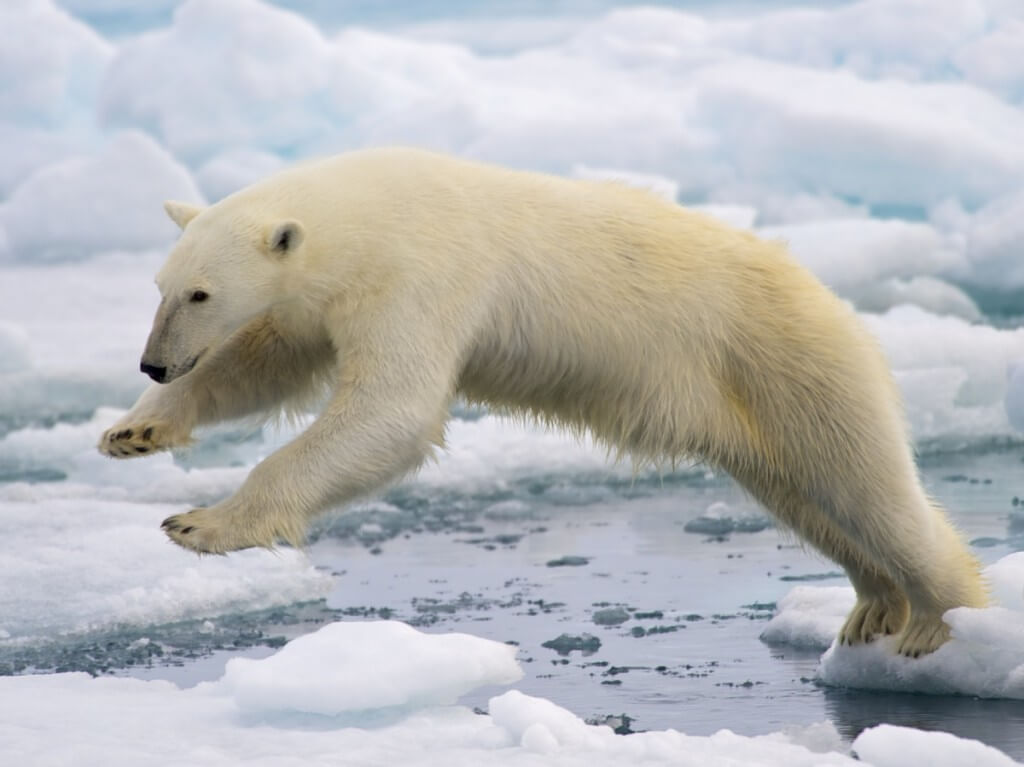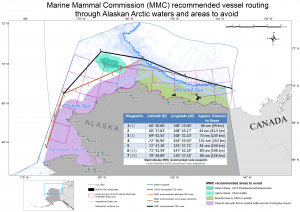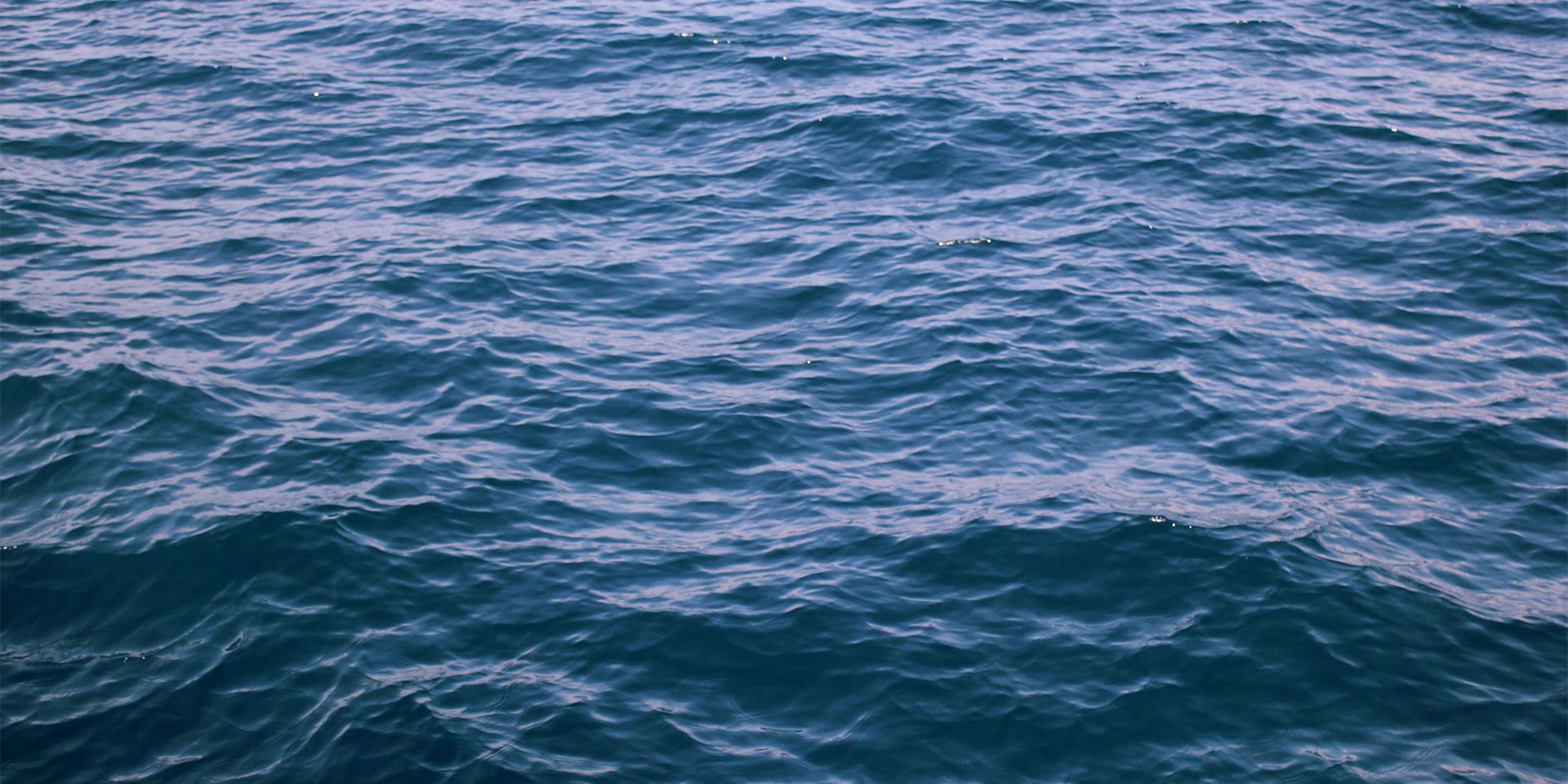Climate Change and the Arctic
Introduction
The global climate is changing, and the Artic is on the front line. Satellite imagery illustrates the dramatic loss of sea ice over the last several decades as air and water temperatures in the Arctic have warmed – one of many documented changes being tracked and reported on annually. The loss of sea ice in the Arctic has led to accelerated ocean warming, stronger winds and currents, and accelerated shoreline erosion in Arctic communities (Moon et al. 2019).
Marine mammals endemic to the Arctic are uniquely adapted to life in icy waters. These include bowhead whales, polar bears, several species of “ice seals,” beluga whales, and walruses. These and other marine species (e.g., Arctic seabirds) rely on the year round or seasonal presence of sea ice. Other species (e.g., humpback, fin, and gray whales) migrate to the Arctic from more temperate regions to feed during the summer months. These species follow the receding sea ice edge and take advantage of the region’s immense summer biological productivity.
The Marine Mammal Commission has long sought to further scientific understanding of the impacts of environmental changes on marine mammals, including Arctic-specific impacts, by working with and bringing together experts to discuss and publish the latest science. The Commission engages with other agencies on policy and management actions, such as assessing the conservation status of marine mammals in the Arctic and elsewhere that may be impacted by changing environmental conditions in U.S. waters (Gulland et al. 2022). The Commission supports baseline research and environmental monitoring in U.S. waters and around the Arctic to document changes to marine ecosystems, and engages in conservation and co-management of marine mammals with Alaska Native communities and federal and state resource agencies.
Environmental Changes and Impacts to Marine Mammals
Impacts of Sea Ice Declines

Polar bears, walruses, and other Arctic species are facing similar challenges as summer sea-ice continues to retreat. (National Park Service)
Sea ice is declining rapidly in both quantity and quality, with profound consequences for marine mammals that rely on sea ice platforms for foraging, resting, molting, hunting, reproduction, and refuge from predators. These shifts may result in reduced fitness of individual animals, changes in population abundance (Laidre et al. 2015) and altered migratory behaviors and distributions (Hauser et al. 2017, Szesciorka and Stafford 2022).
A frequently cited example of how the decline in sea ice is affecting Arctic marine mammals is the polar bear, which relies upon sea ice to hunt seals, although these impacts vary by region and polar bear population. Generally, as the ice extent decreases, polar bears must spend more time and travel greater distances in search of prey, which can result in poor body condition and reduced reproductive success (Pagano et al. 2021, 2024). Polar bears have also responded to declines in sea ice by moving onto land to forage (Galicia et al. 2021, Rode et al. 2022), bringing them closer to human communities and increasing the potential for inter-species conflict (Atwood and Wilder 2021). Efforts to mitigate conflict, like the North Slope Borough’s Polar Bear Patrol Program or the use of “Bear-dar” in Churchill, Manitoba, which alerts the community to approaching polar bears, can help to keep both bears and humans safe.
Walruses in the Chukchi Sea have similarly been forced onto land to rest (or haul out) in large numbers (Garlich-Miller 2012) as sea ice extent retreats into deep waters beyond shallower walrus foraging areas (Jay et al. 2017, MacCracken 2012). The need to rest on land increases the species’ vulnerability to disturbance from predators or human activities. Disturbances can cause walruses to stampede, resulting in mass mortality from crushing, particularly of calves or smaller individuals (MacCracken 2012). When sea ice is unavailable, walruses also travel farther to forage and migrate, which increases their energetic demands. These and other effects of climate change and anthropogenic disturbance are likely to lead to a decline in the overall abundance and population growth rate of walrus (Johnson et al. 2024).
Ringed seals rely upon dense continuous pack ice and snow cover to dig lairs for shelter from weather and predation (especially when pupping). Loss of ice and decreased snow depth in a warming Arctic compromises the structure of lairs and may negatively affect adult body condition and pup survival (Hauser et al. 2021). Bearded seals prefer to haul out on broken ice pack (Ray et al. 2010). With the reduction of sea ice extent, bearded seals appear to be hauling out more frequently on land (Olnes et al. 2020, 2021). The extent to which ringed and bearded seals are switching from sea ice to land haulouts, or the impact of this or other behavioral adaptations to changing conditions on their reproductive success (Gryba et al. 2021), are not yet fully known.
Changes to the Food Web: Prey and Pathogens
Many Arctic marine mammals will also be indirectly affected as the food webs on which they depend undergo changes. Restructured food webs, changes in prey populations, the arrival of new marine mammal species (including new predators and competitors), and pathogens from more temperate seas will challenge Arctic species (Barratclough et al. 2023, Huntington et al. 2020, Meuter et al. 2021, Moore and Gulland 2014, Moore and Reeves 2018).
Several studies have found that harmful algal blooms (HABs) are expanding north as sea ice extent declines and water temperatures rise (e.g., Lefebvre et al. 2016). HAB paralytic toxins like saxitoxin and domoic acid have been found in walruses, seals, and Arctic cetacean species (Lefebvre et al. 2016, 2022). More consistent and widespread monitoring of toxin levels in marine mammals and other marine species may help to alert scientists to potential HAB-related risks to both human and marine mammal health (Lefebvre et al. 2022).
Threats from Increasing Human Activity
Declines in the seasonal extent of sea ice are creating more opportunities for human activity in the Arctic, with resulting impacts on marine mammals (e.g., Hauser et al. 2018, Huntington et al. 2020, Moore and Reeves 2018, Reeves et al. 2014). The disappearance of sea ice from coastlines earlier in the year, coupled with the ice’s retreat farther from shore during the summer (and tendency to remain offshore longer) means there is now a large and increasing annual window of open water. These changes create opportunities for shipping, tourism, commercial fishing, oil and gas exploration and development, and military operations to expand into new areas. These activities create the potential to expose Arctic marine mammals to a variety of new threats, including vessel strikes, pollution, entanglement in fishing nets or lines, and exposure to human-caused sound and other forms of disturbance.
At the same time, these changing ice and weather conditions are affecting the movements of marine mammals and the conditions for subsistence hunting of marine mammals by Alaska Natives. Extended open water periods, lack of stable sea ice, high winds, stronger currents, and the need to venture farther from shore to hunt marine mammals along the ice edge may present new dangers in pursuing subsistence hunting activities (Hauser et al. 2021, Huntington et al. 2017). There are also concerns over the potential danger to or conflict with subsistence hunters from new “industrial” or shipping activities in the Arctic.

Marine Mammal Commission recommended vessel routing for the Arctic PARS.
The predicted increase in Arctic shipping has prompted the U.S. Coast Guard to seek input on vessel routing measures that would minimize impacts of shipping on marine mammals and Arctic communities. The Commission’s comments on the U.S. Coast Guard’s Alaskan Arctic Coast Port Access Study (Arctic PARS) were based on an analysis of best available scientific data on marine mammal distributions and seasonal movements in the U.S. Chukchi and Beaufort Seas. The Commission worked with biologists at NOAA and Duke University to generate recommended vessel routing through Alaskan Arctic waters and areas to avoid in order to protect marine mammals. The Commission also prepared a fact sheet summarizing its comments on the Arctic PARS.
2016 Alaska Listening Sessions
On February 3 – 11, 2016, the Commission held a series of listening sessions in Alaska to gain an understanding of how climate change is impacting Alaska Native communities and the marine mammals upon which they depend. We visited communities in Barrow, Kotzebue, and Nome to receive input from Alaska Native communities and other regional partners. Some of the themes we heard at the listening sessions were the need for federal agencies to enhance communication and consultation with Alaska Native communities and the need to incorporate traditional/Indigenous Knowledge into federal decision-making.
Moving Forward
Although many scientists have emphasized known and expected negative impacts on Arctic marine mammals (e.g., Barratclough et al. 2023, Florko et al. 2021, Hauser et al. 2017, Huntington et al. 2020, Laidre et al. 2015, Moore and Reeves 2018), some species or populations are likely to experience little change or benefit from more favorable conditions.
If the impacts of climate change on Arctic species are to be avoided, the source of the problem on a global scale will have to be addressed. Regardless of the degree to which society and governments are able to alter the course of global warming, our challenge in the short-term is to understand the effects of climate change on the Arctic, and anticipate and mitigate the impact on Arctic species and the Alaska Native communities that depend on them to the fullest extent possible.
ADDITIONAL RESOURCES
General Information
Climate Change and the Arctic – Alaska Native Subsistence Hunting (Factsheet)
National Oceanic and Atmospheric Administration – Climate Change
National Oceanic and Atmospheric Administration – Ocean Acidification
National Air and Space Administration – Climate Change
Literature Cited
Atwood, T.C., and J.M. Wilder. 2021. Human-Polar Bear Interactions in Davis R.W. and A.M. Pagano (eds.) Ethology and Ecology of Sea Otters and Polar Bears. Springer.
Barratclough, A. et al. 2023. A review of circumpolar Arctic marine mammal health—A call to action in a time of rapid environmental change. Pathogens 12:937.
Druckenmiller, M.L., T. Moon, and R. Thoman. 2021. The Arctic in Blunden, J. and T. Boyer (eds.) State of the Climate in 2020. Bulletin of the American Meteorological Society 102:S263–S315.
Florko, K.R.N. et al. 2021. Predicting how climate change threatens the prey base of Arctic marine predators. Ecology Letters 24:2563–2575.
Galicia M.P. et al. 2021. Polar bear diet composition reveals spatiotemporal distribution of Arctic marine mammals across Nunavut, Canada. Ecological Indicators 132:108245.
Garlich-Miller, J. 2012. Adapting to Climate Change: a Community Workshop on the Conservation and Management of Walruses on the Chukchi Sea coast, United States Fish and Wildlife Service, Marine Mammals Management, Anchorage, AK.
Gryba, R. et al. 2021. Indigenous Knowledge of bearded seal (Erignathus barbatus), ringed seal (Pusa hispida), and spotted seal (Phoca largha) behaviour and habitat use near Utqiaġvik, Alaska, USA. Arctic Science 7:832–858
Gulland, F.M.D., et al. 2022. A review of climate change effects on marine mammals in United States waters: Past predictions, observed impacts, current research and conservation imperatives. Climate Change Ecology 3:100054.
Hauser, D.D.W. et al. 2017. Decadal shifts in autumn migration timing by Pacific Arctic beluga whales are related to delayed annual sea ice formation. Global Change Biology 23:2206–2217.
Hauser D.D.W., K.L. Laidre, and H.L. Stern. 2018. Vulnerability of Arctic marine mammals to vessel traffic in the increasingly ice-free Northwest Passage and Northern Sea Route. PNAS 115:7617-7622.
Hauser, D.D.W., J. Beaudreau, J. Brown, and H.P. Huntington. 2021. Co-production of knowledge reveals loss of Indigenous hunting opportunities in the face of accelerating Arctic climate change. Environmental Research Letters 16:095007.
Hauser, D.D.W., K.J. Frost, and J.J. Burns. 2021. Ringed seal (Pusa hispida) breeding habitat on the landfast ice in northwest Alaska during spring 1983 and 1984. PLoS ONE 16: e0260644.
Huntington H.P., L.T. Quakenbush, and M. Nelson. 2017. Evaluating the Effects of Climate Change on Indigenous Marine Mammal Hunting in Northern and Western Alaska Using Traditional Knowledge. Frontiers in Marine Science 4:319.
Huntington, H.P. et al. 2020. Evidence suggests potential transformation of the Pacific Arctic ecosystem is underway. Nature Climate Change 10:342–348.
Jay C.V., et al. 2017. Walrus haul-out and in water activity levels relative to sea ice availability in the Chukchi Sea. Journal of Mammalogy 98:386–396.
Johnson, D.L., J.M. Eisaguirre, R.L. Taylor, and J.L. Garlich-Miller. 2021. Assessing the population consequences of disturbance and climate change for the Pacific walrus. Marine Mammal Science 37:1513–1531.
Laidre, K. L. et al. 2015. Arctic marine mammal population status, sea ice habitat loss, and conservation recommendations for the 21st century: Arctic Marine Mammal Conservation. Conservation Biology 29, 724–737
Lefebvre, K. A. et al. 2016. Prevalence of algal toxins in Alaskan marine mammals foraging in a changing arctic and subarctic environment. Harmful Algae 55:13–24.
Lefebvre, K. A. et al. 2022. Paralytic shellfish toxins in Alaskan Arctic food webs during the anomalously warm ocean conditions of 2019 and estimated toxin doses to Pacific walruses and bowhead whales. Harmful Algae 114.
MacCracken, J.G. 2012. Pacific walrus and climate change: observations and predictions. Ecology and Evolution 2:2072–2090.
Mueter, F.J. et al. 2021. Possible future scenarios in the gateways to the Arctic for Subarctic and Arctic marine systems: II. prey resources, food webs, fish, and fisheries. ICES Journal of Marine Science 78:3017-3045.
Moon, T.A. et al. 2019. The Expanding Footprint of Rapid Arctic Change. Earth’s Future 7:212-218.
Moore, S.E. 2016. Is it ‘boom times’ for baleen whales in the Pacific Arctic region? Biology Letters 12:20160251. http://dx.doi.org/10.1098/rsbl.2016.0251
Moore, S.E., and F.M.D. Gulland. 2014. Linking marine mammal and ocean health in the “new normal” Arctic. Ocean and Coastal Management 102:55-57.
Moore et al. 2014. Marine fishes, birds and mammals as sentinels of ecosystem variability and reorganization in the Pacific Arctic Region. Chapter 11 in J.M. Grebmeier and W. Maslowski (eds.) The Pacific Arctic Region: Ecosystem Status and Trends in a Rapidly Changing Environment. Springer Science + Business Media, Dordrecht.
Moore S.E., and R.R. Reeves. 2018. Tracking arctic marine mammal resilience in an era of rapid ecosystem alteration. PLoS Biology 16(10): e2006708.
Olnes J., et al. 2021. Juvenile bearded seal response to a decade of sea ice change in the Bering, Chukchi, and Beaufort seas. Marine Ecology Progress Series 661:229-242.
Olnes, J. et al. 2022. Movement, diving, and haul-out behaviors of juvenile bearded seals in the Bering, Chukchi and Beaufort seas, 2014–2018. Polar Biology 43:1307–1320.
Pagano, A. M., et al. 2021. Effects of sea ice decline and summer land use on polar bear home range size in the Beaufort Sea. Ecosphere 12:e03768.
Pagano, A. M., et al. 2024. Polar bear energetic and behavioral strategies on land with implications for surviving the ice-free period. Nature Communications 15:e12345.
Ray, G.C., J.E. Overland, and G.L. Hufford. 2010. Seascape as an organizing principle for evaluating walrus and seal sea-ice habitat in Beringia. Geophysical Research Letters 37:L20504.
Reeves R.R. et al. 2014. Distribution of endemic cetaceans in relation to hydrocarbon development and commercial shipping in a warming Arctic. Marine Policy 44:375-389.
Rode, K.D., et al. 2022. Observed and forecasted changes in land use by polar bears in the Beaufort and Chukchi Seas, 1985–2040. Global Ecology and Conservation 33:e02319.
Szesciorka, A.R., and K.M. Stafford. 2022. Sea ice directs changes in bowhead whale phenology through the Bering Strait. Environmental Research Letters 17:064007.
